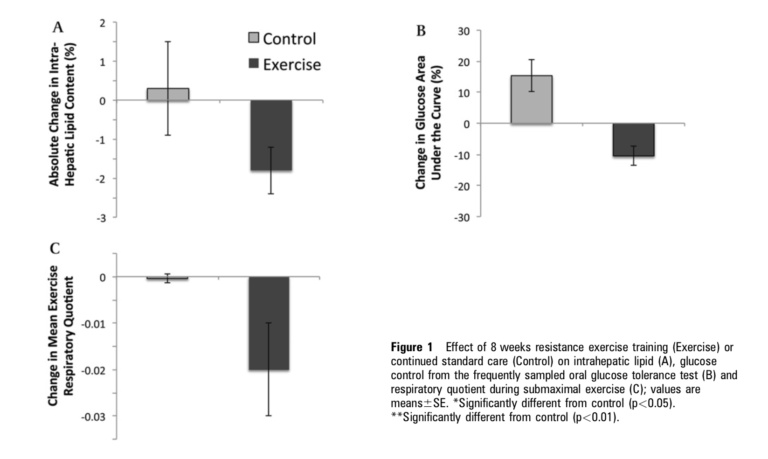Previous research has consistently shown diet and exercise regimens that cause weight loss — regimens often including aerobic exercise — also reduce the amount of fat in the liver (1). In this 2011 trial, researchers tested whether resistance exercise alone could do the same, even without causing weight loss.
Nineteen sedentary, obese adults with early-stage fatty liver disease were randomized to a training group or control. The trained group was put through a resistance training circuit three times per week for eight weeks; controls maintained their usual, minimal levels of activity. The intensity and duration of training increased throughout.
Trained subjects lost neither overall fat mass nor overall body weight. They did, however, see a 13% decrease in liver fat content. They also experienced improved insulin sensitivity, as measured both by HOMA-IR and OGTT AUC (2).
The authors argue these metabolic improvements are linked. Other studies have repeatedly shown exercise increases muscle’s ability to take up glucose and oxidize fat (3, this topic was also previously discussed on CrossFit.com). These improvements reduce circulating glucose, triglyceride, and insulin levels, which in turn reduces fat production by the liver (de novo lipogenesis). In other words, resistance exercise improves muscle’s ability to effectively regulate circulating glucose and fat levels, a change that reduces insulin resistance and liver fat buildup.
At minimum, this indicates resistance exercise alone may help reverse insulin resistance and fatty liver disease. More importantly, it suggests treatments that induce weight loss — such as other changes to diet and exercise — may drive more rapid and effective metabolic improvements when paired with resistance training.
References
- Goodpaster BH, Katsiaras A, Kelley DE. Enhanced fat oxidation through physical activity is associated with improvements in insulin sensitivity in obesity. Diabetes. 52.9(2003): 2191-7. Available here.
- Stumvoll M, Mitrakou A, Pimenta W, Jenssen T, Yki-Järvinen H, Van Haeften T, Renn W, Gerich J. Use of the oral glucose tolerance test to assess insulin release and insulin sensitivity. Diabetes Care. 23.3(2000): 295-301. Available here.
- Holten MK, Zacho M, Gaster M, Juel C, Wojtaszewski JF, Dela F. Strength training increases insulin-mediated glucose uptake, GLUT4 content, and insulin signaling in skeletal muscle in patients with type 2 diabetes. Diabetes. 53.2(2004): 294-305. Available here.
